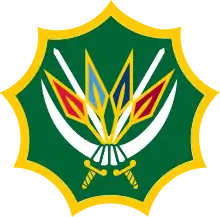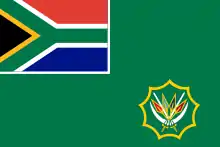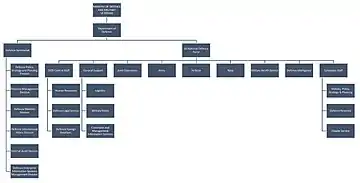South African National Defence Force
The South African National Defence Force (SANDF) comprises the armed forces of South Africa. The commander of the SANDF is appointed by the President of South Africa from one of the armed services. They are in turn accountable to the Minister of Defence and Military Veterans of the Defence Department.
| South African National Defence Force | |
|---|---|
10 other official names:
| |
 Emblem of the SANDF | |
 Flag of the SANDF | |
| Founded | 1912 |
| Current form | 1994 |
| Service branches | Military Health Service |
| Headquarters | Pretoria, South Africa |
| Leadership | |
| Commander in chief | President Cyril Ramaphosa |
| Minister of Defence and Military Veterans | Nosiviwe Mapisa-Nqakula |
| Chief of the SANDF | General Solly Shoke |
| Manpower | |
| Military age | 18–49 |
| Available for military service | 10,354,769 males, age 18–49 (2005), 10,626,550 females, age 18–49 (2005) |
| Fit for military service | 4,927,757 males, age 18–49 (2005), 4,609,071 females, age 18–49 (2005) |
| Reaching military age annually | 512,407 males (2005), 506,078 females (2005) |
| Active personnel | 74,508 (2019)[1]:165 |
| Reserve personnel | 15,107 (2014)[2] |
| Expenditures | |
| Budget | US$4.278 billion[3] |
| Percent of GDP | 1.3% (2016) |
| Industry | |
| Domestic suppliers | Denel, Paramount Group, Reutech Radar Systems |
| Foreign suppliers | AgustaWestland, BAE Systems, Heckler & Koch, IVECO, MAN, Saab AB, Thales, ThyssenKrupp |
| Related articles | |
| History | Military history of South Africa List of wars involving South Africa |
| Ranks | South African military ranks |
The military as it exists today was created in 1994,[4][5] following South Africa's first multiracial election in April of that year and the adoption of a new constitution. It replaced the South African Defence Force and also integrated uMkhonto we Sizwe (MK) and the Azanian People's Liberation Army (APLA) guerilla forces.
History
The SANDF took over the personnel and equipment from the SADF and integrated forces from the former Bantustan homelands forces,[6]:5 as well as personnel from the former guerrilla forces of some of the political parties involved in South Africa, such as the African National Congress's Umkhonto we Sizwe, the Pan Africanist Congress's Azanian People's Liberation Army and the Self-Protection Units of the Inkatha Freedom Party (IFP).The Azanian People's Organization' s AZANLA was invited but refused to be integrated and to this day remains the only guerrilla force not integrated into the current force. [4]
As of 2004, the integration process was considered complete, with retaining personnel, structure, and equipment from the SADF. However, due to integration problems, financial constraints, and other issues, the SANDF faced capability constraints.[7]
The South African Commando System was a civil militia active until 2008, based upon local units from the size of company to battalion.[8] In its final years its role was to support the South African Police Service during internal operations. During such deployments the units came under SAPS control.
According to the Defence Ministry's 2014 Defence Review, the SANDF is "in a critical state of decline".[9] A series of cuts to its capital and operating budgets compromised a number of capabilities.[10] Equipment is largely obsolete due to inadequate maintenance, while renewal has stalled with devastating effect on South Africa's defence industry.
Re-armament
In 1999, a R30 billion (US$4.8 billion) purchase of weaponry by the South African Government was finalised, which has been subject to allegations of corruption.[11][12] The South African Department of Defence's Strategic Defence Acquisition purchased frigates, submarines, light utility helicopters, lead-in fighter trainer and multirole combat aircraft.[13]
Domestic operations

The SANDF is involved in a number of internal operations, including:[14]
- Safeguarding the Border (Operation CORONA)
- Disaster relief and assistance (Operation CHARIOT)
- Safety and security (Operation PROSPER)
- Ridding the country of illegal weapons, drug dens, prostitution rings and other illegal activities (Operation FIELA)
International operations
The SANDF partakes in UN peacekeeping missions, mostly on the African continent. It also provides election security when needed.
Organisation and structure
Overall command is vested in an officer-designated Chief of the SANDF (CSANDF). Appointed from any of the Arms of Service, they are the only person in the SANDF at the rank of General or Admiral, and is accountable to the Minister of Defence and Veteran Affairs, who heads the Department of Defence
The structure of the SANDF is depicted below:[15]

In 2010, a Defence Amendment Bill created a permanent National Defence Force Service Commission (NDFSC), a body that will advise the Minister of Defence and Military Veterans on the improvement of conditions of service of members of the South African National Defence Force (SANDF).[16]
Members of the Commission include the Chiefs of the service arms, as well as the Chief of Defence Intelligence as well as the Chief of Joint Operations
Four armed services make up the forces of the SANDF:[17]
The Joint Operations Division is responsible for co-ordinating all Joint Operations involving any or all of the four services. The South African Special Forces Brigade is the only organic unit under the direct command of the Joint Operations division. Unlike most other special forces it is not part of the Army or any other branch of the SANDF.[18]
Publications and Access to Records
The SANDF publishes (or provides links) to documents describing its strategy, plans, performance, white papers and related government acts. Under the Promotion of Access to Information Act 2000 (PAIA), the SANDF also provides access to current and historical information the SANDF holds and provides a manual[19] with procedures for obtaining access. Some categories of records are "automatically available" that are "available without a person having to request access in terms of the PAIA. These records can be accessed at the Department of Defence Archives and include operational records of the 1st World War, 2nd World War, Korean War, and establishment of the Union Defence Force 1912.
Personnel

On 31 March 2019, the demographics of service personnel were as follows:[1]:165
The gender split in the SANDF as of 31 March 2019 is as follows:[1]
- 51,684 men (69.4%)
- 22,824 women (30.6%)
The target for female recruits increased to 40% in 2010.[20]
2012 Defence Review
The South African Defence Review 2012 is a policy review process carried out by a panel of experts, chaired by retired politician and former Minister of Defence, Roelf Meyer. The review was commissioned by Lindiwe Sisulu the then Minister of Defence and Military Veterans, in July 2011. The review was motivated by the need to correct the errors and shortcomings of the previous review. According to defence minister Lindiwe Sisulu, the old report was no longer relevant to South Africa's current situation.[21]
See also
References
- 2018/19 Department of Defence Annual Report (PDF). South Africa: South African Department of Defence. 2019. p. 402.
- "South Africa: South African National Defence Force". DefenceWeb. 1 February 2013. Archived from the original on 21 October 2014. Retrieved 21 October 2014.
- "National Treasury Budget 2012: Estimates of National Expenditure" (PDF). www.treasury.gov.za. Department of National Treasury. Archived (PDF) from the original on 18 November 2017. Retrieved 19 January 2018.
- "Constitution of the Republic of South Africa Act 200 of 1993 (Section 224)". South African Government. 1993. Archived from the original on 12 June 2008. Retrieved 23 June 2008.
- L B van Stade (1997). "Rationalisation in the SANDF: The Next Challenge". Institute for Security Studies. Archived from the original on 16 March 2016. Retrieved 23 June 2008.
- Wessels, André. "The South African National Defence Force, 1994–2009: A Historical Perspective" (PDF). humanities.ufs.ac.za/. University of the Free State. Archived from the original (PDF) on 1 August 2013. Retrieved 21 October 2014.
- U.S. Embassy The Hague, 05THEHAGUE2973 Netherlands/Africa: DASD Whelan's visit to The Hague Archived 11 November 2011 at the Wayback Machine, 1 November 2005, via Wikileaks United States diplomatic cables leak
- Potgieter, Thean; Liebenberg, Ian (October 2012) [2012]. Reflections on War – Preparedness and Consequences. Stellenbosch: Sun Media Stellenbosch. ISBN 978-1-920338-84-8.
- Dörrie, Peter (9 April 2014). "South Africa's Military Is Falling Apart". medium.com. War is Boring. Archived from the original on 13 April 2014. Retrieved 9 April 2014.
- Staff writer (27 November 2020). "South Africa's army is out of money – here's how bad things are". businesstech.co.za. Business Tech. Retrieved 2 December 2020.
- Buthelezi, Mangosuthu (22 November 2007). "Mangosuthu Buthelezi's Weekly Newsletter to the Nation". Ifp.org.za. Inkatha Freedom Party. Archived from the original on 3 December 2008. Retrieved 13 November 2008.
- Bright hopes betrayed Archived 3 March 2016 at the Wayback Machine Mail & Guardian
- Neethling, Theo (22 July 2010). "Military spending, socio-economic challenges and foreign policy demands: Appraising South Africa's predicament". African Security Review. 15 (4): 57–78. doi:10.1080/10246029.2006.9627622. ISSN 2154-0128. S2CID 154830936.
- "C J OPS Briefs Media on Deployments". Archived from the original on 19 December 2012. Retrieved 22 January 2013.
- "Department of Defence Annual Report 2018/19" (PDF). Parliamentary Monitoring Group. Retrieved 28 September 2020.
- "PCODMV adopts Defence Amendment Bill". DefenceWeb.co.za. DefenceWeb. 18 October 2010. Archived from the original on 21 October 2014. Retrieved 21 October 2014.
- "Defence Act 42 of 2002" (PDF). South African Government. 12 February 2003. p. 18. Archived from the original (PDF) on 24 June 2008. Retrieved 23 June 2008.
- "Fact file: The Joint Operations Division". DefenceWeb. 28 November 2008. Archived from the original on 13 December 2013. Retrieved 13 March 2013.
- "Promotion of Access to Information (PAI) Manual" (PDF). South African Government Department of Defence. 7 March 2016. Archived (PDF) from the original on 5 May 2018. Retrieved 5 May 2018.
- "Transformation, Gender Equity and Empowerment in the South African Defence Force: Briefing by Department of Defence | PMG". Archived from the original on 18 September 2012. Retrieved 13 June 2012.
- "Draft Defence Review report released". 12 December 2012. Archived from the original on 7 December 2014.
Further reading
- "South African Defence Review 2012". Defence Review Committee. Archived from the original on 28 July 2012.
- https://www.defenceweb.co.za/sa-defence/sa-defence-sa-defence/landward-force-makes-up-over-half-of-sandf-strength/ - SANDF strength numbers 2014/15